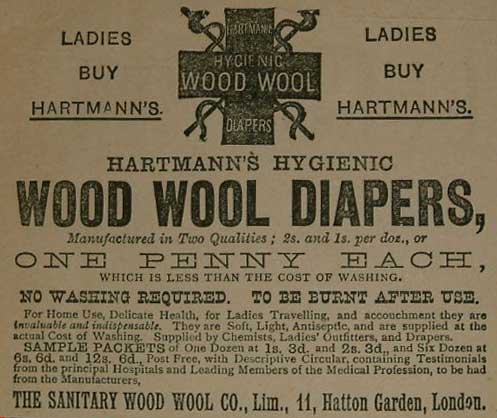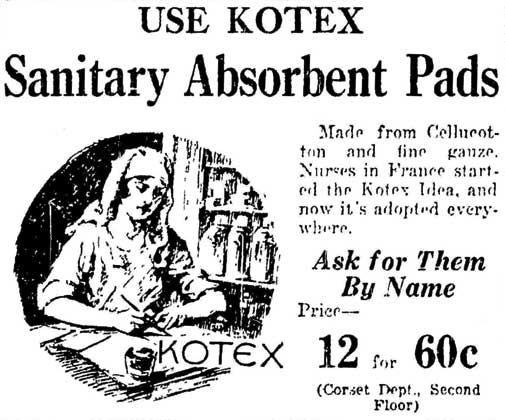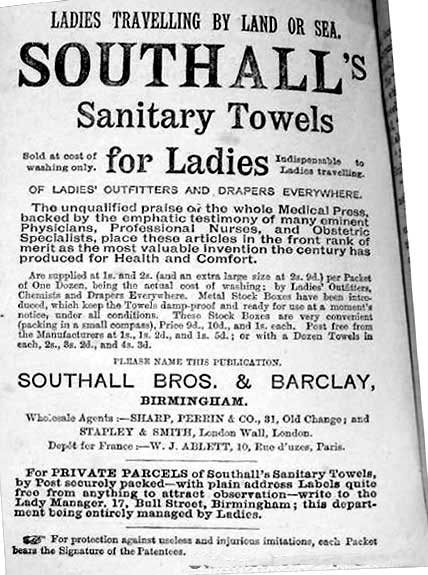A Post for the Ladies. Feminine Hygiene in the Last Century.
Throughout history, women have used a variety of protective pads during menstruation. Most were created at home by using some sort of fabric. The text below was copied from Wikipedia.
Through the ages women have used different forms of menstrual protection. Menstrual pads have been mentioned as early as the 10th century, in the Suda, where Hypatia, who lived in the 4th century AD, was said to have thrown one of her used menstrual rags at an admirer in an attempt to discourage him. The Museum of Menstruation has articles and photos of some early forms of menstrual protection, including among other things knitted pads and menstrual aprons. Women often used strips of folded old cloth (rags) to catch their menstrual flow, which is why the term “on the rag” is used to refer to menstruation.
Disposable menstrual pads grew from Benjamin Franklin’s invention designed to save soldiers with buckshot wounds, but appear to have been first commercially available from around 1888 with the Southall’s pad. The first commercially available American disposable napkins were Lister’s Towels created by Johnson & Johnson in 1896. Disposable pads had their start with nurses using their wood pulp bandages to catch their menstrual flow, creating a pad that was made from easily obtainable materials and inexpensive enough to throw away after use. Kotex’s first advertisement for products made with this wood pulp (Cellucotton) appeared in 1921. Several of the first disposable pad manufacturers were also manufacturers of bandages, which could give an indication of what these products were like. Until disposable sanitary pads were created, cloth or reusable pads were widely used to collect menstrual blood. Women often used a variety of home-made menstrual pads which they crafted from various fabrics, leftover scraps, grass, or other absorbent materials, to collect menstrual blood. Many probably used nothing at all. Even after disposable pads were commercially available, for several years they were too expensive for many women to afford. When they could be afforded, women were allowed to place money in a box so that they would not have to speak to the clerk and take a box of Kotex pads from the counter themselves. It took several years for disposable menstrual pads to become commonplace. However, they are now used nearly exclusively in most of the industrialized world.

My mother told me about the Kelley household with three adolescent girls and their method of dealing with the monthly occurrence of menstruation.
Granny Kelley, being the very fastidious woman that she was, always made white flannel pads that could be folded & reused. I am sure she hemmed them beautifully. Granny kept a bucket of bleach water in the basement and the three Kelley girls would put their used pads into this bucket before they were to be laundered. Granny would wash them, bleach them white, refold them and put them back into the closet for future use. Mom (Harriett) went on to tell me about less fortunate girls who didn’t have a mother like Granny or the means to buy nice flannel fabric. Some of these poor girls had a tough time and often did not smell very nice.
And Some More Kelley Family Photos
I am having to cannibalize the photo albums because Mom glued some of the photos to the pages of the album. But I feel that it is worth it in order to share them.
I love this little photo of Uncle Bob. It looks like someone gave him a coat that was much too big for him.
I wouldn’t want to eat spaghetti or drink red wine while wearing this white uniform. The cleaning bills must have been horrific. And below these two photos is a little out of focus photo of the newlyweds, Uncle Bob & Aunt Helen. They certainly look frisky in this photo.
Below is a photo of Harriett and Ray taken on their first wedding anniversary.
Cousin John emailed me two photos today that I added to the blog. If any family members wish to add anything, please PLEASE do. I can also include you as a “member” of this blog and this will let write or post photos — anything except the power to delete the whole thing. So — you are formally invited. This might work for some family members who are interested but don’t have the time to create their own blog. After all, it is “Posts About Dead Relatives”.
More Thoughts on Adoption, Adoptees and Adoptive Parents
My daughter called me tonight and we talked a bit about my blog. I said that I am trying to be sensitive since I am dealing with the lives of my very much loved relatives. Adoption as it pertains to me was due to babies being born to unmarried mothers. It was a hidden event during the forties, fifties & sixties. And since then, everything has changed. My adopted mother, Harriett, was very aware of this change in social mores and wrote me this poignant note in 1995. I clipped out the center part of the letter as it revealed too much personal information about one of her friend’s unmarried granddaughters who chose to keep her baby.
My parents never concealed the fact that I was adopted. All of the announcements contained the word adopted and it was never a secret in our family. Harriett & Ray were such great parents that I am surprised that Harriett would ever have any doubts in her skills. As a parent, though, I know I have many regrets as to my parenting skills (or total lack of). But as immature as I was, at least I got a chance to grow up with my daughter . And I am still sorry that I never created a fabulous baby book — but of course Nanny (Harriett) did that for me.
Adoption, Adoptees, Adoptive Parents
From 1940 until about 1970, up to 4 million mothers in the United States surrendered their newborn babies to the adoption process.
I’ve copied the text below from Wikipedia
Adoption is a process whereby a person assumes the parenting for another and, in so doing, permanently transfers all rights and responsibilities, along with filiation, from the original parent or parents. Modern systems of adoption, arising in the 20th century, tend to be governed by comprehensive statutes and regulations.
Beginning in the 1940s and 1950s, illegitimacy began to be defined in terms of psychological deficits on the part of the mother. At the same time, a liberalization of sexual mores combined with restrictions on access to birth control led to an increase in premarital pregnancies. In most cases, adoption was presented to the mothers as the only option and little or no effort was made to help the mothers keep and raise the children.
All of that said, I was an extremely lucky newborn and was adopted into a loving and secure family. While I was searching through old photographs today, I found the cross stitch picture that my Mom made for us. They truly felt this way about us and we never doubted their love or loyalty.
More Photos of Granny & Grandfather Kelley
I love looking at old family photos and having the internet and a computer has made sharing them so easy. I have a lot of Daddy Ray’s slides that I need to scan and make into digital files. All families are different in what they save and who ends up with the photos. I remember Granny Kelley having a drawer full of family photos in her attic. I wish I had been old enough at the time to appreciate what they were.
That said, I’ve scanned a few more of the photos that Mom (Harriett) saved.
Kelley Family Photos
My Granny Kelley had twelve grandchildren. We were close in age and loved visiting each other during the summer. This photo was taken at Granny Kelley’s home in Winfield, Kansas in 1952. I am in the back row between my cousin Mark and cousin Tim. I would have been one year old. In the front row from left to right — Christie, Joe, baby Barbara on Susan’s lap, Granny holding baby Peter, next Mary and behind Mary is Pat. And to the right is John holding baby Martha.
I left my adopted Mother’s script on the bottom of the photo. She had very pretty and distinctive handwriting and printing. My mother, Harriett, is in the front left bottom corner. She labeled herself as “Mom”. I don’t know when this photo was taken. Forest Aaron Kelley was a doctor in Winfield, Kansas. He was an early believer in the danger of smoking. When he attended his Lodge meetings, he would sit near an open window while the rest of the men smoked cigars, cigarettes & pipes. His initials are F.A. Kelley, so the men started calling him “Fresh Air Kelley”
They Shoot Horses, Don’t They? (refering to horses with broken legs)
I’m not ready to make plans for the upcoming holidays. I broke my left leg, (fibula, the small bone on left side) on November 5, 2012 and I’m in a cast to the knee. I have another appointment with the orthopedic doctor in two weeks. As of today, I am lucky to make it from the computer to the kitchen to the bathroom and back.

So, I am having a difficult time getting excited about holiday travel. Maybe I’ll be walking by then — but I really can’t plan that far ahead. I’m excited that someone is willing to pick up my sorry self and take me to the club this afternoon to play bridge.
I love this photo on the outside of the box my cast protector came in. I don’t think it represents the sort of individual who would buy this product. Seriously, if I looked this happy I’d be on my way to Bermuda or the Bahamas! (Especially if I looked like she does.) But this protector has at least given me a chance to take a shower.

At least I don’t live in the early pioneer days. All they could do was to find a couple of sticks, push the bones together as best they could and then tie some rags around the whole thing to keep the bones in place until they hopefully healed back together.
Bonesetting as a profession was often left to woman.
One famous bonesetter was Sarah Mapp, or “Crazy Sally” as she was often called.
Sarah Mapp was born around 1706, daughter to a bonesetter, and took up her father’s trade. In 18th Century England bonesetters were medical practitioners found in many towns. They reset dislocated hips and shoulders, re-broke and set poorly mended fractures, and sometimes effected various other kinds of cures through bone manipulation, anticipating chiropractic. Resetting of dislocated limbs required a great deal of strength and in many towns the job was given over to the strongest man, usually the blacksmith. Sarah was very strong. She was also cross-eyed, very fat, and “hideously ugly” from contemporary reports. Well aware of her appearance, Sarah capitalized on it, calling herself Crazy Sally or Crosseyed Sally in her public reports.
But then, if I lived in England during those times, I could hitch a ride over to the town of Bath to partake in the healing hot waters at the spas.
Joseph J. Bernstein, Another Tough World War II Veteran. He lived May 5, 1923 – May 29, 2008
Joseph (Jack) Bernstein was my daughter’s grandfather & my father-in-law. Jack was tough. He smoked Marlboro Reds when I first met him, had rough hands and an iron handshake. Jack was probably always tough, but especially since he survived being captured at sea by the Germans and then being turned over to a Japanese war camp to spend the rest of WWII. This is for Jack, R.I.P. and we miss you.
His son wrote
Thursday, Jack was declared dead . . .for the second time. He was 85. Sixty-five years ago, another article appeared in the Kansas City Star; the headline read, “And a Boy Dies At Sea.” It told the story of a young Kansas Citian in greasy overalls working on a merchant marine tanker — the boy and the tanker lost at sea when an enemy torpedo struck. Insurance benefits were paid and he was given up for dead, by all but his family. “We were deeply grieved to hear of the death of your son,” the letter to his mother read. “He set an example in heroism and patriotism for all of us.”
The text below is copied from http://www.usmm.org/calcutta.html
It wasn’t until 1943 that Washington learned that 27 crew members of the Calcutta were alive and prisoners of war at Camp Fukuoka in Japan.
He often remarked that he was living on borrowed time. At 11:35pm on May 29, 2008, he opened his eyes for the last time and closed them. All who knew him will miss him dearly.
My Favorite Veteran, Raymond F. Page, (aka Daddy Ray), A Proud World War II Marine
My father, Raymond F. Page, was one of the nicest & most honest men I have ever met. He grew up in the oil fields of central Kansas. His father, Fred Page, kept the oil pumps working for their owners and didn’t make a lot in return. Ray was born November 8, 1913 in Lincoln County, Kansas to Frederick Copeland Page and Myrtle Revella Shaver Page. He died June 22, 1998 in Wichita, Kansas. Raymond F. Page was my adopted father.
Ray received a full scholarship to attend Southwestern College in Winfield, Kansas during the Depression. The scholarship was provided as long as he kept one of their buildings clean. In return, he got to sleep on a cot in the basement. While at Southwestern College he met my mother, Harriett Kelley. Harriett was a Home Economics major who attended college while living at home with her parents. Life was a slightly easier for the Kelleys. Her father (Forrest Aaron Kelley, M.D.) was a physician in Winfield and often received food as payment during the Depression.
Raymond F. Page & Harriett N. Kelley married on June 11, 1939.
From left to right, Fred Page (Ray’s father), Robert Kelley (Harriett’s brother), Reva Shaver Page (Ray’s mother), the minister, Ray Page (the groom) and Harriett Kelley (the bride), Mary Romick Kelley (Harriett’s mother), Forrest Kelley (Harriett’s father), Nadine Page (Ray’s baby sister), Earl Page (Ray’s brother), Patricia Kelley (Harriett’s sister) & Margaret Kelley (Harriett’s sister).
My father was a bit old for World War II. Right before he was to be drafted into the Army, he enlisted in the U.S. Marine Corp in hopes that he might have a better chance of survival. Ray had already graduated with a degree in Business and Accounting from Southwestern College and because of this, he was taken into the Marine Corp. at a higher rank. Luckily for Ray, his main wartime duty was to be a pay officer in Hawaii. The younger men called him “Pops”, and he spent his time in Hawaii making sure they all received their pay on time.
I Can’t Say Enough Nice Things about the Volunteers at www.findagrave.com
Yesterday I received an email from a Kenneth Schaeffer, a volunteer at http://www.findagrave.com He found my birth mother’s gravestone & posted a photo of it on the findagrave site.
Kenneth Schaeffer has added 3,876 memorials to findagrave and has taken 580 volunteer photos in the Pennsylvania area.
What is Find A Grave?
Find a Grave’s mission is to find, record and present final disposition information from around the world as a virtual cemetery experience.
If you haven’t taken a look at this site, I urge you to do so. It is a great genealogical resource. Plus, if you have photos to add, it will help the future generations with their research. Anyone with a digital camera can check out the photo requests in their area and post a picture.
Thank you Kenneth!
 </
</
























